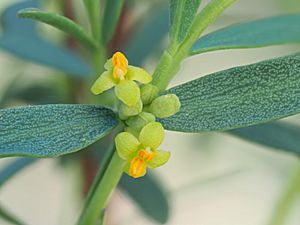Poison rice-flower facts for kids
Quick facts for kids Poison rice-flower |
|
|---|---|
 |
|
| Scientific classification | |
| Genus: |
Pimelea
|
| Species: |
pauciflora
|
Pimelea pauciflora, also known as the poison rice-flower, is a type of shrub. It belongs to the Thymelaeaceae plant family. This plant has small, yellowish-green flowers and smooth, green leaves. It is special because it grows naturally only in Eastern Australia.
Contents
What the Poison Rice-Flower Looks Like
The poison rice-flower is a small shrub that usually grows between 1 and 3 meters tall. It has smooth, long, and reddish stems.
Its leaves are shiny green and feel smooth. They grow in pairs opposite each other along the branches. The leaves are narrow, like a line or a small spear, and measure about 4 to 25 millimeters long and 1 to 4 millimeters wide.
Flowers and Fruit
The flowers of this plant are yellowish-green. They usually grow in small groups of 3 to 9 flowers at the ends of the branches. These flowers are unisexual, which means each flower is either male or female. Male flowers are about 1 to 3 millimeters long, and female flowers are about 3 millimeters long.
The flowers also have two special leaf-like parts called bracts. These bracts are smooth, green, and shaped like an egg. They are about 3 to 11 millimeters long and 2 to 5 millimeters wide.
After the flowers bloom, the plant produces a juicy, red fruit. This fruit is about 4 millimeters wide. As the fruit grows, the flower parts like sepals and petals fall off. The poison rice-flower usually blooms from September to November.
How the Poison Rice-Flower Got Its Name
The plant Pimelea pauciflora was first officially described in 1810. This was done by a botanist named Robert Brown. He published his description in a book called Prodromus Florae Novae Hollandiae et Insulae Van Diemen.
The second part of its scientific name, pauciflora, comes from two Latin words. Pauci means "few," and florus means "flowered." So, pauciflora means "few-flowered," which describes how its flowers grow in small clusters.
Where the Poison Rice-Flower Grows
The poison rice-flower is found in Eastern Australia. In New South Wales, it grows in open scrubland and forests. You can sometimes find it in thick, dense areas at higher altitudes, especially south of Queanbeyan.
In Victoria, this plant grows near mountain streams. It is found in only a few scattered places there.

